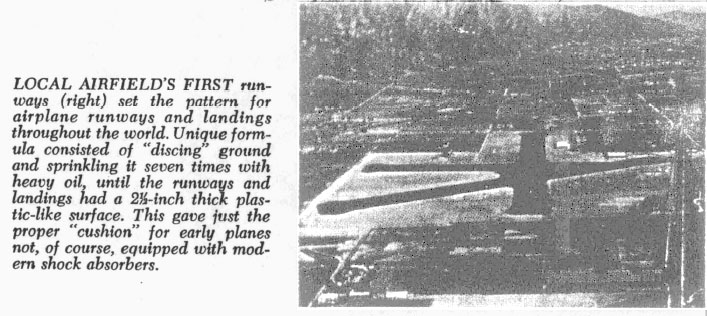
From The Story of
In the early part of 1928 an attorney, by the name of Kenneth Humphries, confided to
Burbank Chamber of Commerce Secretary C. C. Richards that the company he
represented, Boeing
Air Transport Corporation of
Boeing executives had spent a year investigating a number
of possible locations for the airfield in
the Los Angeles area, to find the one most favorable from the standpoint of
weather conditions, availability to a metropolitan district, and &her
important requirements for a major air terminal. Weather experts had spent days
and nights testing air conditions here under all possible circumstances.
A total
of 240 acres of land made up the
original purchase.

Asking price for this land, which ran into the hundreds of
thousands of dollars, was paid in cash, although most of the property owners
would have preferred to have had their money in deferred payments.
Burbank City Council was then requested to donate a section
of
First group of buildings to make up the new Boeing Air Field included
a pretentious structure that housed the executive offices as well as two hangars.
A few years later, what was considered “the world's largest airplane hangar under one roof”
was also constructed on the grounds. Still later, two industrial plants
were added to the group – one for the
In the meantime, name of the airfield had been changed to
Hailed then as "one of the finest airports
in the world," the $1 ½ million United Airport was readied in seven months for United Airports Company of California, Ltd., a
subsidiary of United Aircraft and
Transportation Corporation.
The field was still
a sandy loam vineyard dotted with giant oak and eucalyptus trees. It had a dry river bed running through its
center.
Up until this time Pacific Air Transport was the
only commercial line using the field. The company operated one flight a
day on the Seattle-San Diego run, using a single-engine Boeing 40B biplane that carried four passengers
and a pilot.
The 40-acre tract now occupied by Lockheed’s A-1 plant was
formerly
In 1934 the
field became known as Union Air Terminal. It was in
1941 that it was re-named Lockheed Air Terminal when it was purchased by Lockheed Aircraft Corporation.
Since then it has grown from its original 240 acres to 500 acres,
and from a valuation of less than $2 million
to a replacement value of $40 million.
With its two 6000-foot
runways, Lockheed Air
Terminal is today the largest privately-owned commercial airport in the world!
